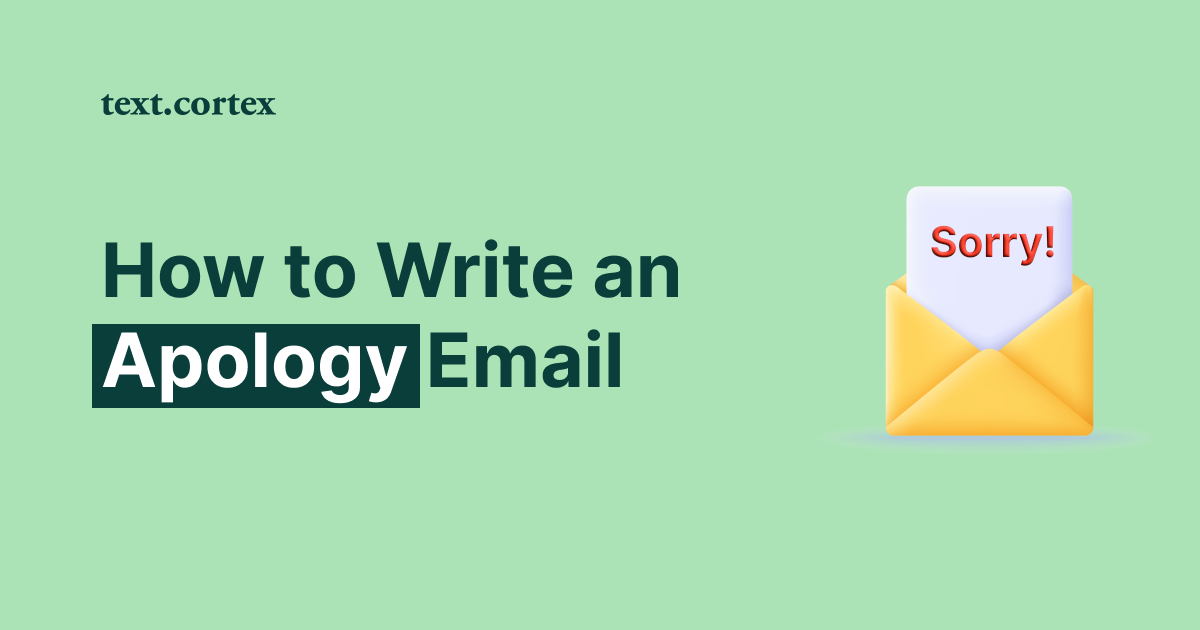Tired of having to create new emails from scratch every time you need one for things like event planning?
Different email strategies for different campaigns are needed for every business opportunity.
However, it can be a waste of time and motivation to compose these emails by hand.
As you may be aware, one of the most important factors in convincing potential attendees to sign up for such an event is the level of personalization included in the invitation emails sent to them.
According to statistics, around 78% of marketers already use email for personalized communication.
Today we’ll guide you through the right ways to include event planning emails in your business strategy, and what to include when crafting them.
In addition, you’ll get the top 5 event planning email outreach templates to use for your future email campaigns.
Let’s start!
What Is Event Planning Email Outreach?
Email outreach is a strategy used in event planning to reach potential customers, partners, or other stakeholders to promote an upcoming event.
You can use this type of email outreach to increase event awareness, generate interest in attending, and build relationships with potential attendees or sponsors.
Furthermore, event planning emails are an excellent way to coordinate logistics and confirm details with those involved in the event.
Writing such emails usually includes details such as the date, time, location, and other pertinent information related to the event.
They may also contain requests for quotes, estimates, and more.
When Are We Sending Event Planning Emails?
When sending event planning emails, you should give vendors and venues time to prepare for the event and allow attendees plenty of time to respond.
So it would be best if you aim to send out your event planning emails at least one month in advance.
What Are the Benefits of Event Planning Email Outreach?
Event planning email outreach offers several benefits, including:
🎯Increased efficiency — Allow you to quickly and easily reach out to multiple vendors and venues to find the best rates and services.
🎯Cost savings — Enable you to compare quotes and find the best deal by reaching out to multiple vendors.
🎯Improved organization — Help you stay organized and keep track of all the details related to the event.
🎯Improved communication — Ensure everyone involved in the event is on the same page and aware of any changes or updates.
And before we jump to our top 5 event planning outreach templates list, let’s first check what to include when writing them.
Event Planning Email Checklist [+ Examples]
Standard patterns apply to the majority of emails. That means crafting attention-grabbing subject lines, writing engaging email bodies, and including a clear call to action.
In this section, we'll talk about the more refined details you should incorporate for your event planning emails, which will vary depending on your relationship with the email recipient.
Note: Moreover, every section includes a sample of the appropriate data structure to help you quickly and easily create your own templates.
Let’s begin!
1. The Purpose of The Event and Its Expected Outcome✔️
When planning an event via email, it is crucial to outline its goals and outcomes. This will ensure that all attendees are on the same page and working towards a common goal.
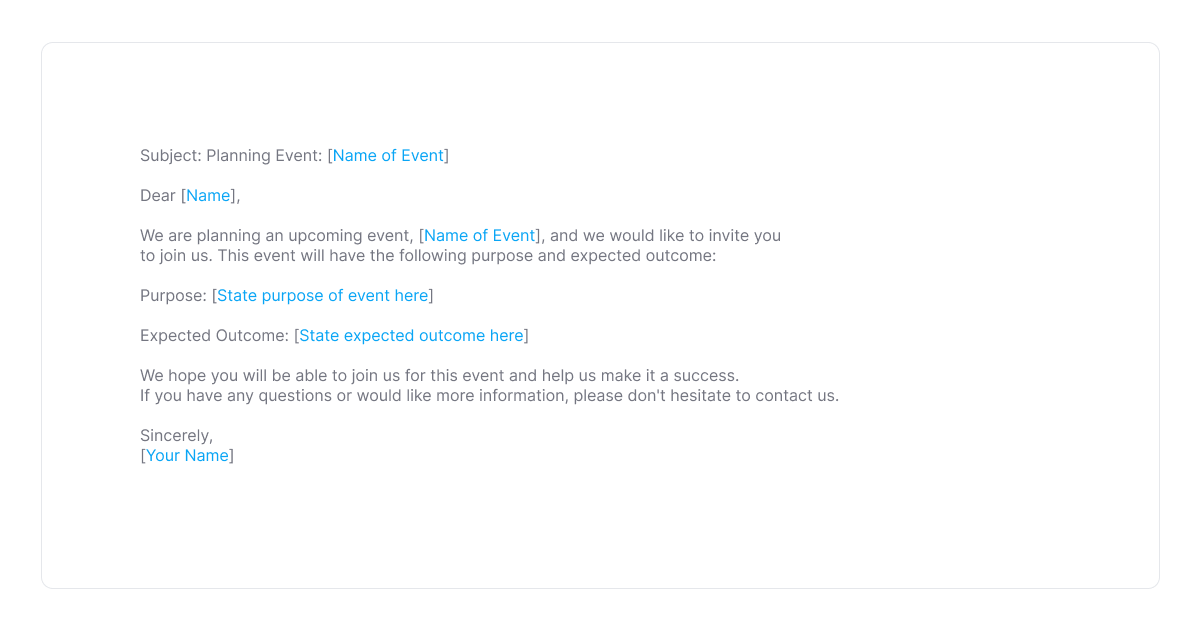
Additionally, the most critical factor in determining whether or not your recipients are interested in attending the event is the transparency of the information provided, such as the event's purpose.
2. The Date, Time, and Location of The Event✔️
Including pertinent information in the email invitation, such as the event's location, date, and time, is the second most crucial aspect of event planning emails.
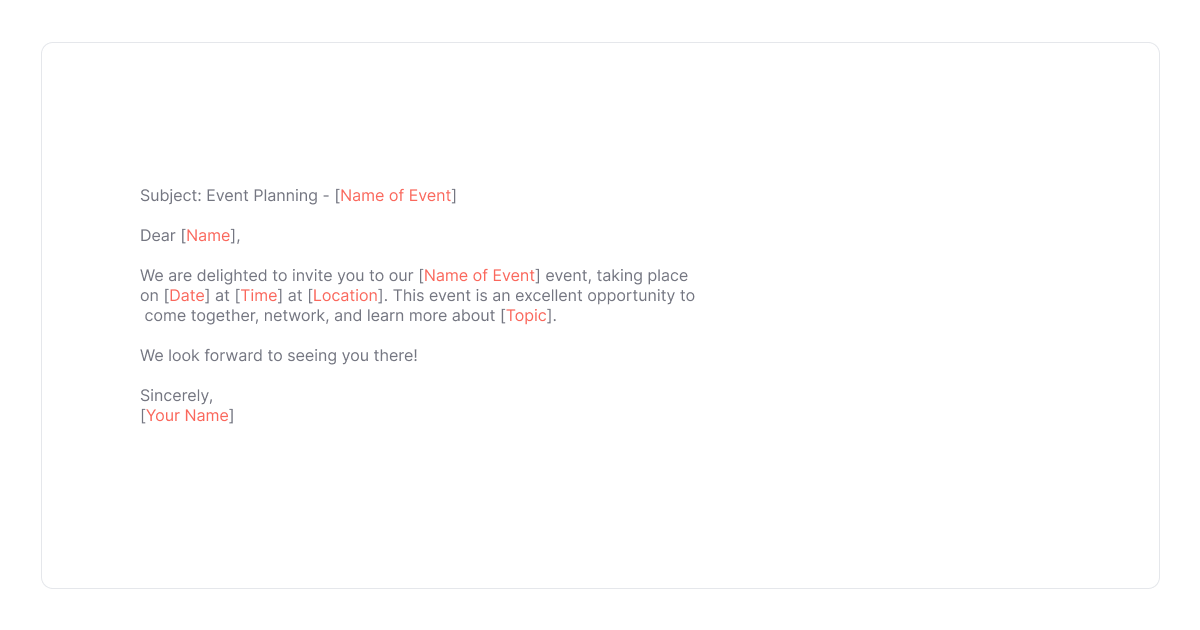
3. A Detailed Agenda of Activities and Speakers✔️
When planning an event, it's essential to include a detailed agenda of activities and speakers in an email to everyone involved.
The schedule lays out the people who will be present, the topics that will be covered, and the times at which various events will occur.
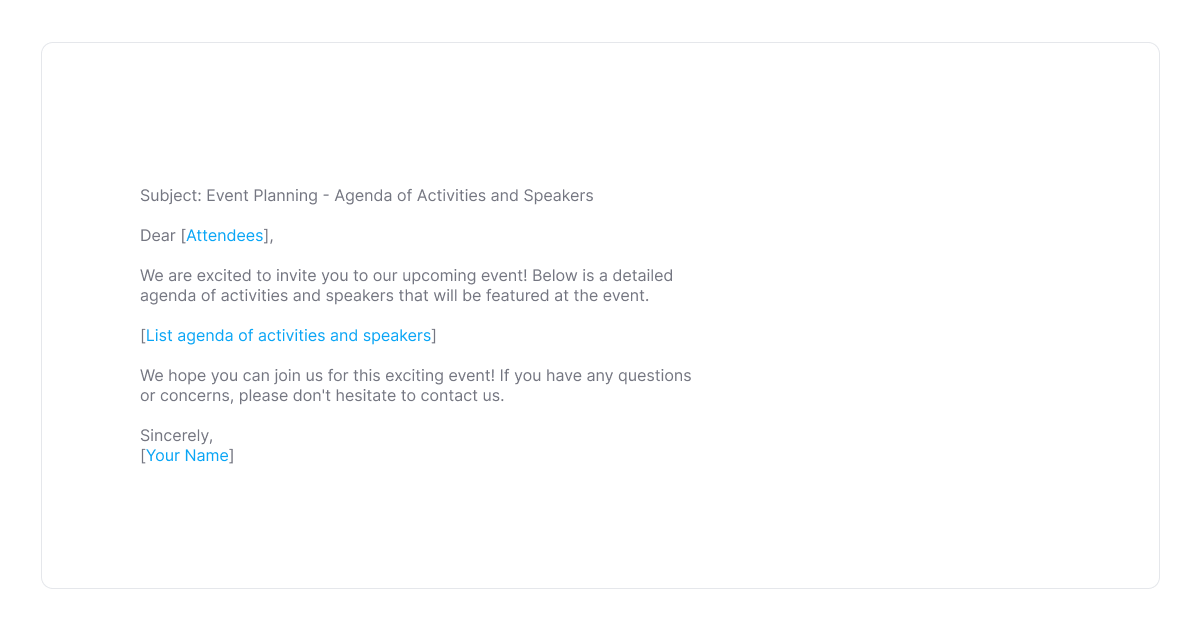
This allows everyone to plan accordingly and ensure that the event runs smoothly.
Moreover, it helps to promote a sense of organization and encourages active participation from everyone.
4. A List of Necessary Supplies and Equipment✔️
A planning email would benefit from including a list of needed supplies and equipment for several reasons.
It can help ensure nothing is forgotten and that everything is accounted for.
It can also help streamline the event planning process because all necessary items can be identified and ordered ahead of time.
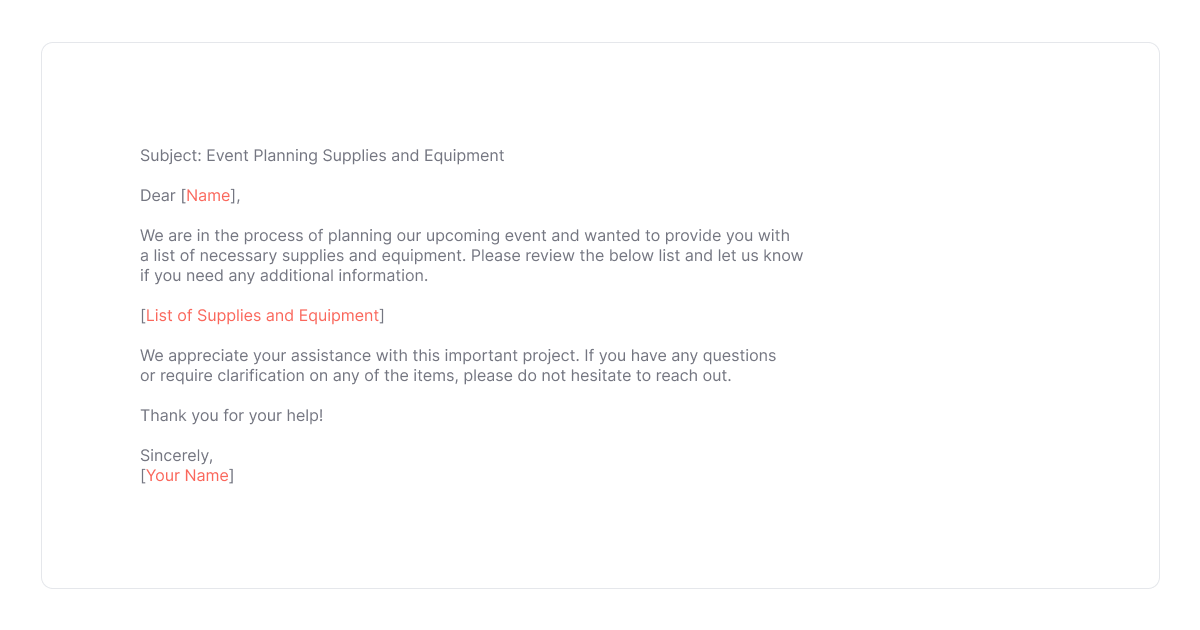
Likewise, by ensuring that only the essential items are bought or rented, having a list of supplies and equipment can help to control costs.
5. The Budget For the Event and Details on How It Will Be Funded✔️
You can ensure that everyone involved clearly understands the costs associated with the event and where the money is coming from by including information about how the event will be funded.
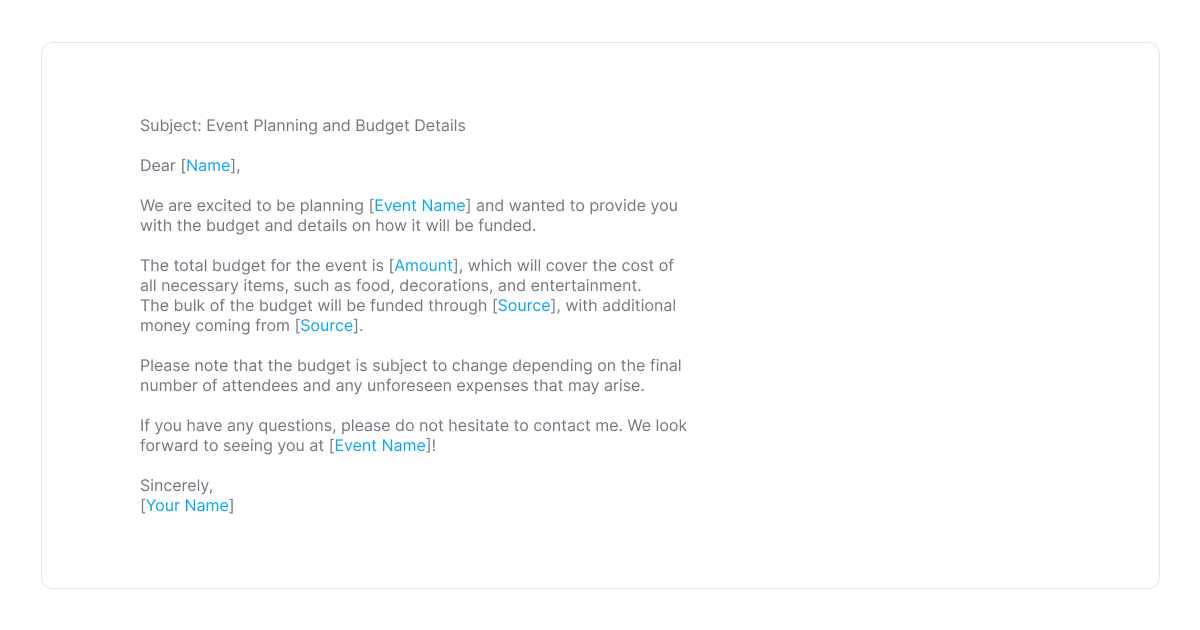
Including such information in your emails can also help prevent any misunderstandings or disputes down the line.
6. A Timeline of Tasks and Deadlines✔️
It's helpful to include a timeline of tasks and deadlines in an email for planning an event so that people can get a handle on things in advance.
It offers a framework everyone can work within and keeps people on track.
Also, it can be used to remind people of their obligations and delegate tasks.
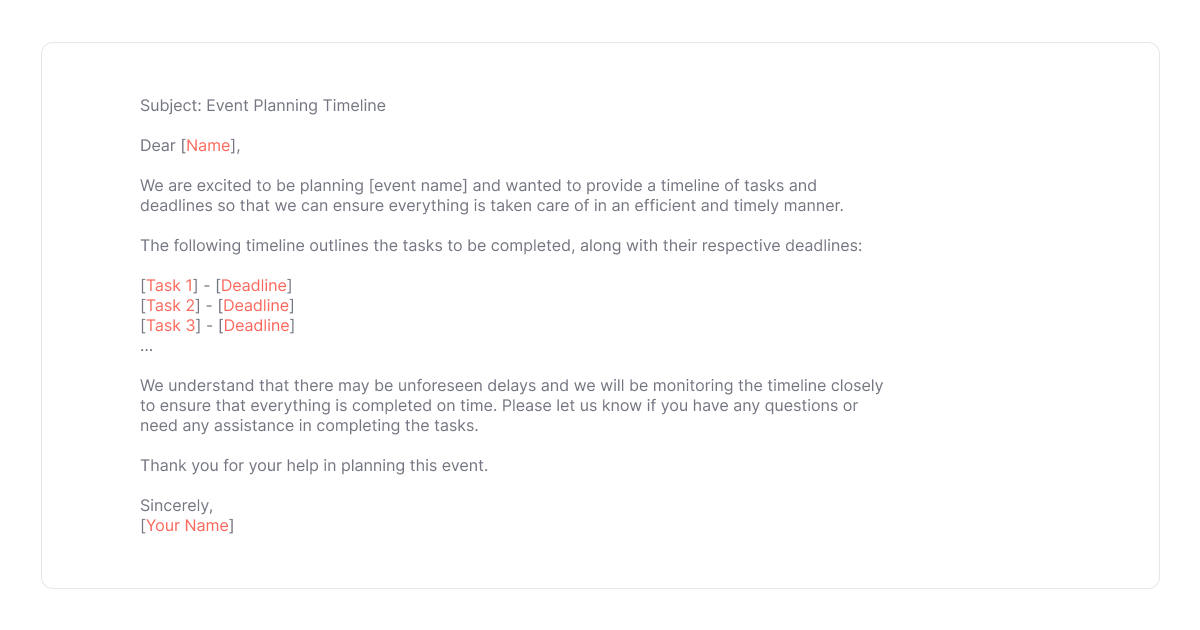
Additionally, having a timeline of tasks and deadlines allows everyone to see the progression of the event planning process.
7. Contact Information For Any Vendors or Partners Involved With the Event✔️
Including contact information for any vendors or partners involved in event planning emails so that everyone knows who to contact with any questions or concerns.
That information also helps streamline communication so that all parties get updates that may occur during the planning process.
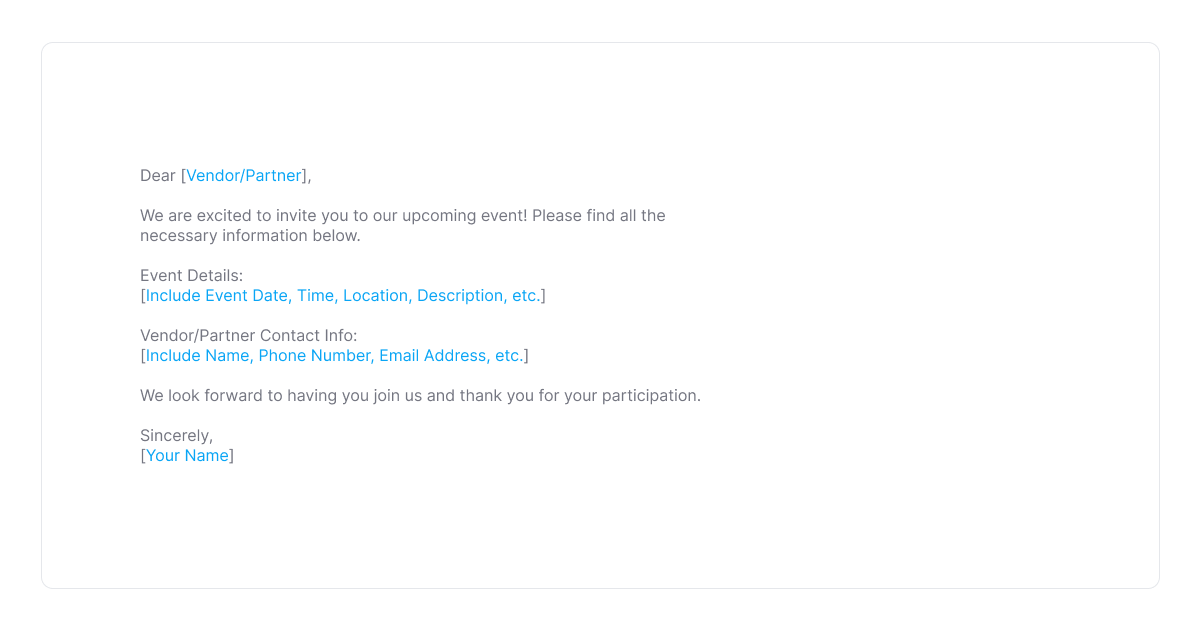
Likewise, including contact information ensures that all parties involved have the necessary information and that any issues arise are addressed promptly and efficiently.
8. An Invitation To the Event With a Call-To-Action✔️
The purpose of the event invitation and call-to-action in event planning emails is to get people to sign up for the event.
A "call-to-action" is a direct request for the reader to perform some sort of action, such as visiting a link, signing up for something, or buying something.
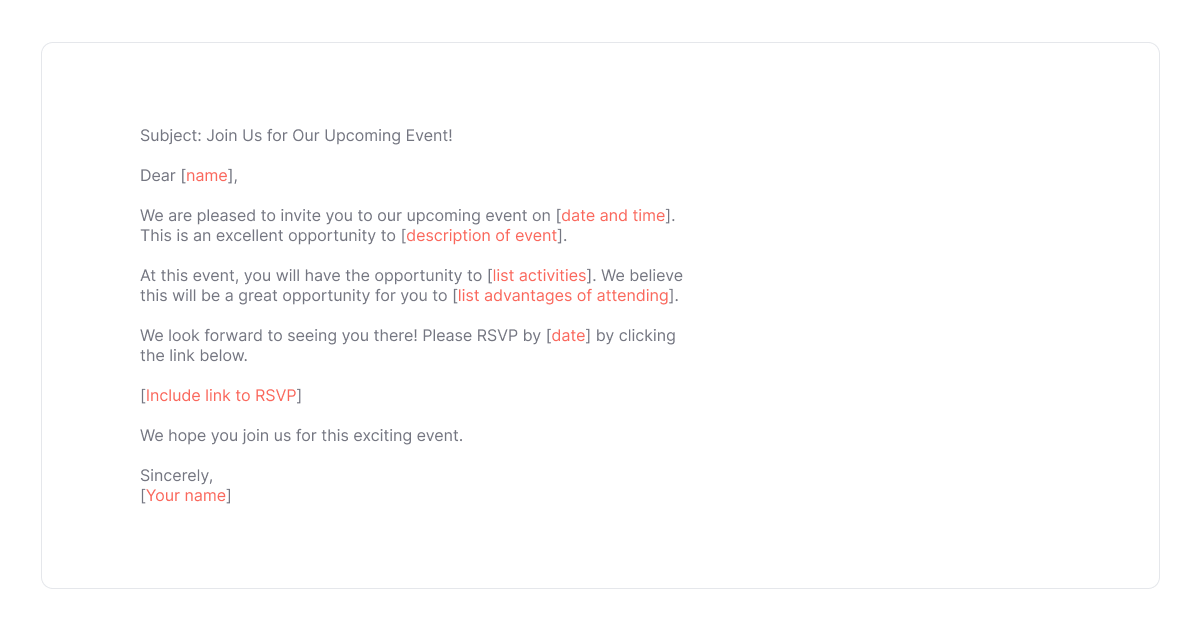
By including a call-to-action in your emails, you can increase the likelihood that people will take the desired action.
In addition, it can help to drive more traffic to your website, which can lead to increased sales and revenue.
9. A Follow-Up Survey or Questionnaire to Measure the Success Of the Event✔️
Including a follow-up survey or questionnaire provides feedback from attendees on how the event went and what could be improved upon for future events.
The survey or questionnaire should cover topics such as overall satisfaction with the event, how well the event goals were met, and which aspects need improvement.
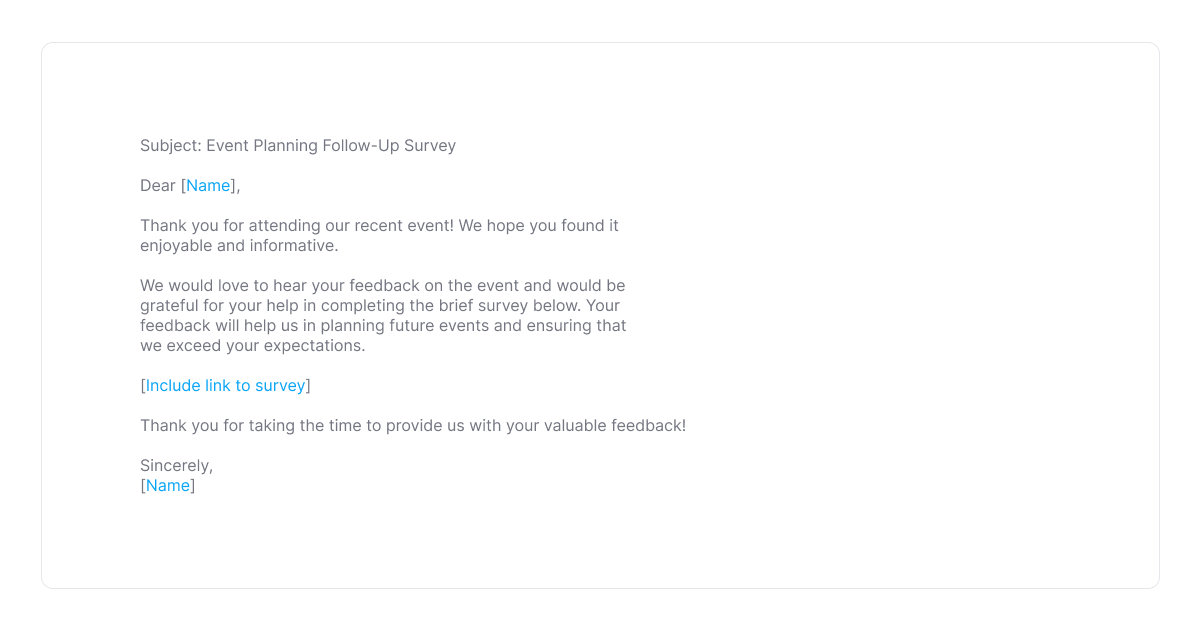
This feedback can then be used to plan future events more effectively.
Also, the survey results can be used to provide evidence of the success of the event to sponsors, funders, and other stakeholders.
5 Top Event Planning Email Outreach Templates To Use In 2023
1. Promoting Your Keynote Email Template
If you're going to use email to promote your keynote, make sure to give your audience a clear and compelling reason to attend.
Provide details about the event, such as who will be speaking and who is sponsoring, as well as a link to the registration page.
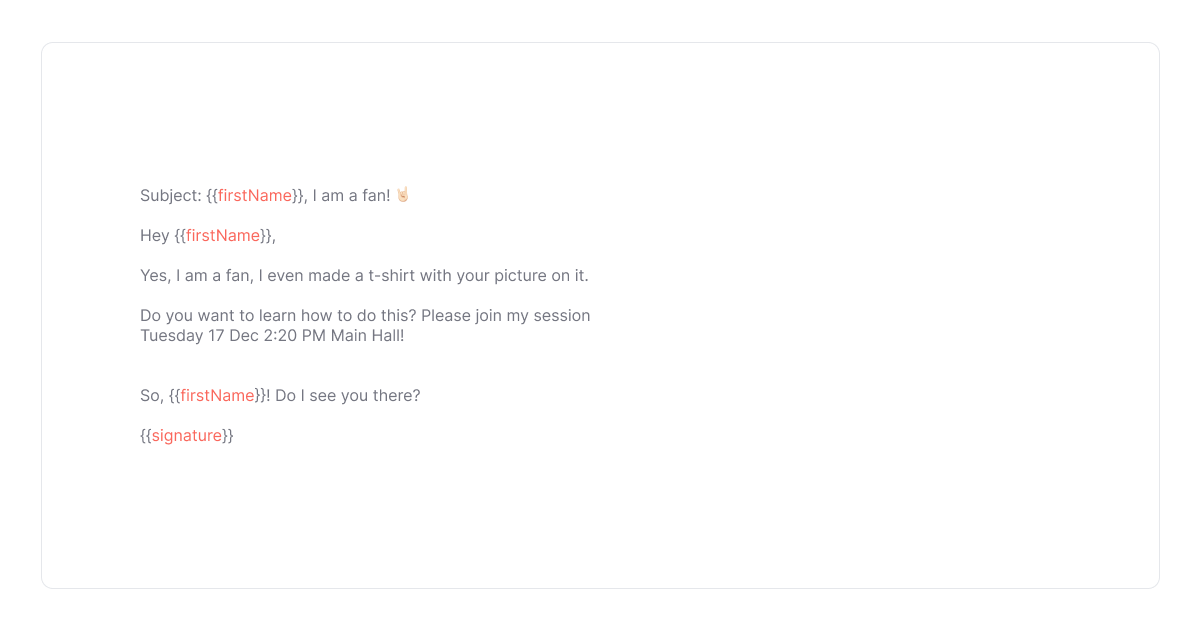
Also, make sure to include call-to-action in your event description and encourage readers to take action and sign up.
2. Conference Announcement Email Template
Conference announcement emails are a great way to let people know about upcoming events.
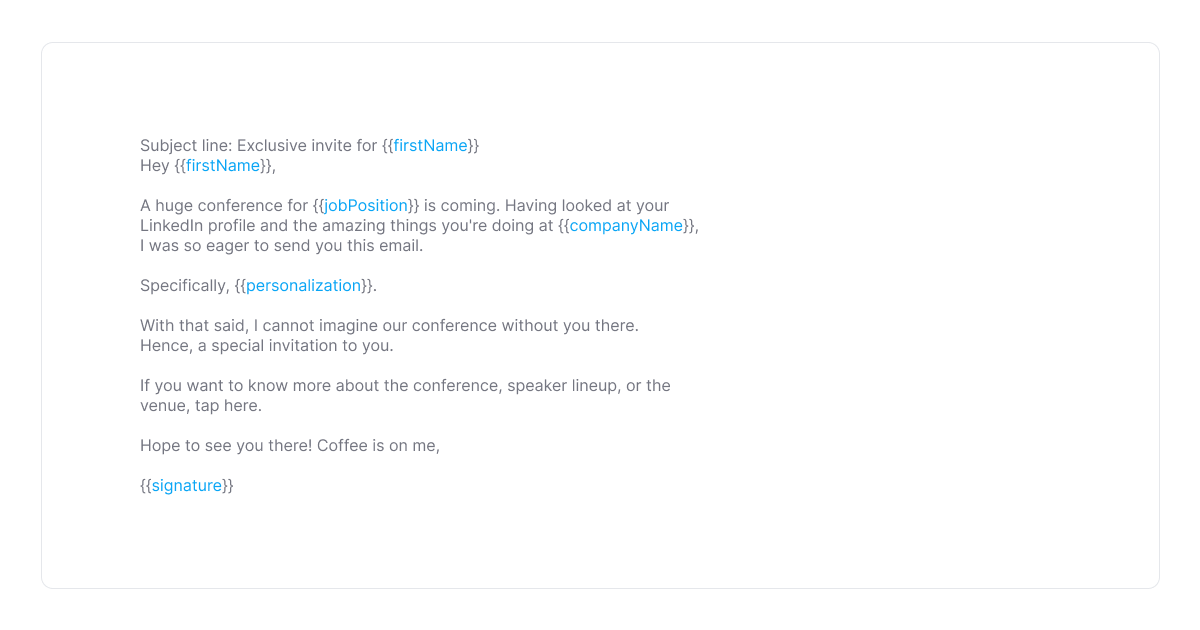
You can use this template to send out invitations, reminders, and updates to potential attendees.
3. Webinar Email Template
You can use a webinar email template to promote an upcoming webinar to potential attendees.
Provide more information about the webinar, share the webinar’s agenda, and encourage people to register for the webinar.
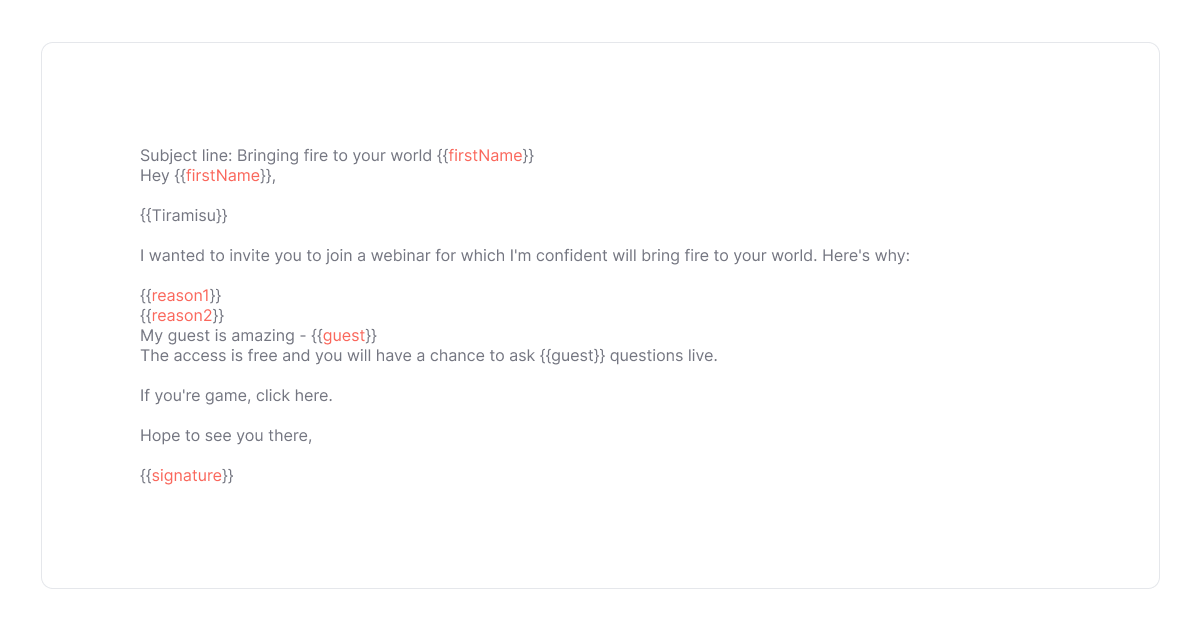
You can also use a webinar email template after the webinar to thank attendees, provide follow-up information, and offer special discounts or bonuses.
4. Exclusive Invite Email Template
Exclusive invite emails are an excellent way to target a specific group of people who are likely to be interested in what you are offering.
Moreover, they can help you to create a sense of urgency and exclusivity around an event or product launch.
.png)
Compared to a more general email campaign, exclusive invite emails can help to increase engagement and conversion rates.
5. Event Invitation Email Template
Emails used for event invitations you can use to invite recipients to any type of event, including a wedding, business conference, awards presentation, or birthday party.
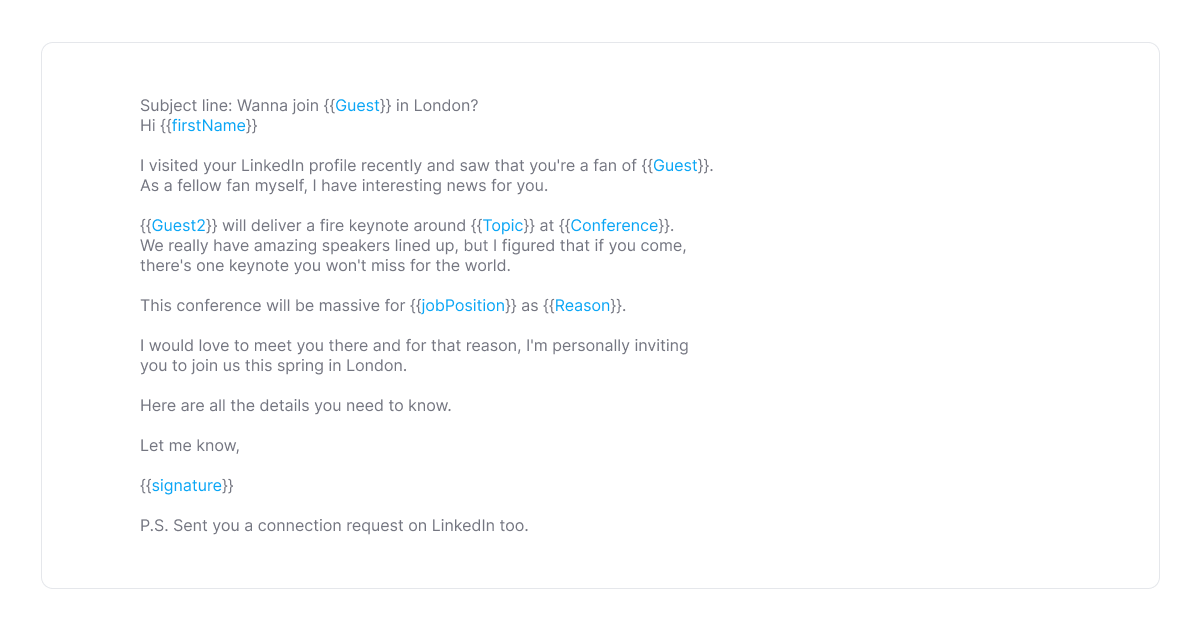
These emails typically contain information about the event, including the date, time, venue, and any other pertinent details.
Also, make sure to include a call-to-action and ask the recipient to RSVP or a link to an online RSVP form.
Bonus: Write Fresh Event Planning Emails Without Templates
Templates are a great way to have a ready-to-send version of event planning emails on hand.
But how about automatically generating event planning email templates from a bulleted list of relevant information?
TextCortex rewriting add-on offers such functionality.
All you need to do is to write your primary takeaways in the form of bullets, highlight them, and choose the ‘Bullet to email’ feature from the menu.
Within seconds you will get your ready-to-sent email draft, which you can further tweak by combining other convenient features such as rewriting, tone, auto-completing, expanding, and more.
By utilizing the TextCortex Chrome extension you can also:
✅ Reduce your writing time by 70%.
✅ Leverage AI writing, rewriting and editing on 30+ online platforms.
✅ Produce any content type with 60+ available templates without leaving your textbox.
✅ Get instant feedback on readability of your content.
Tempted to give it a try?
Get your TextCortex add-on to discover a wide range of content creation features that will enable you to consistently produce high-quality content.

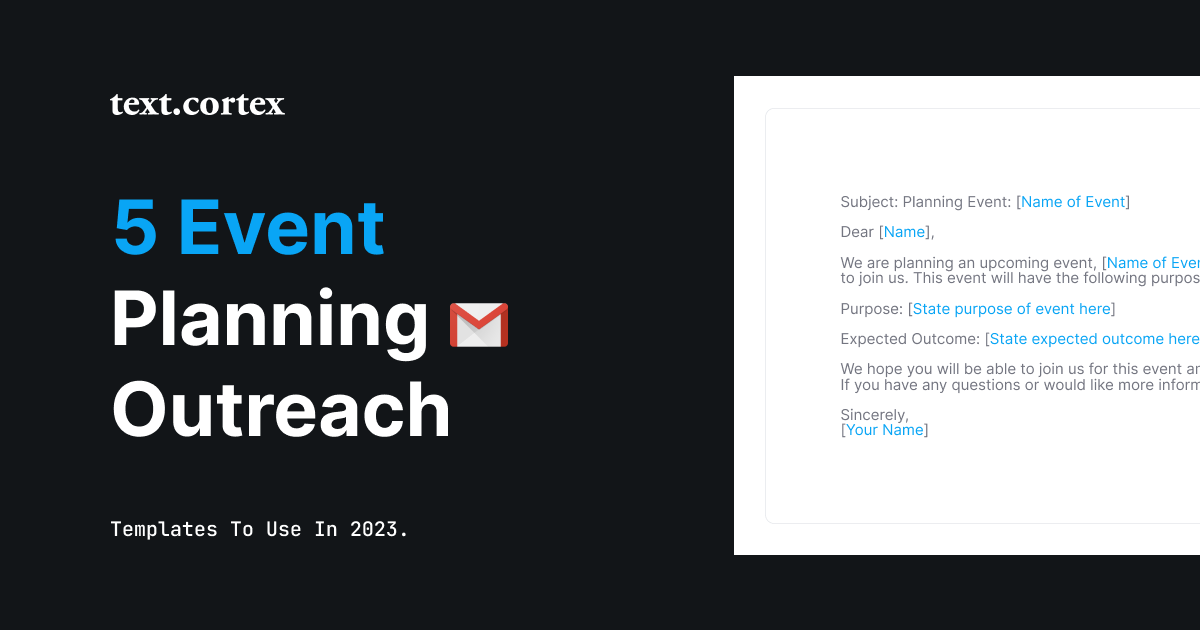
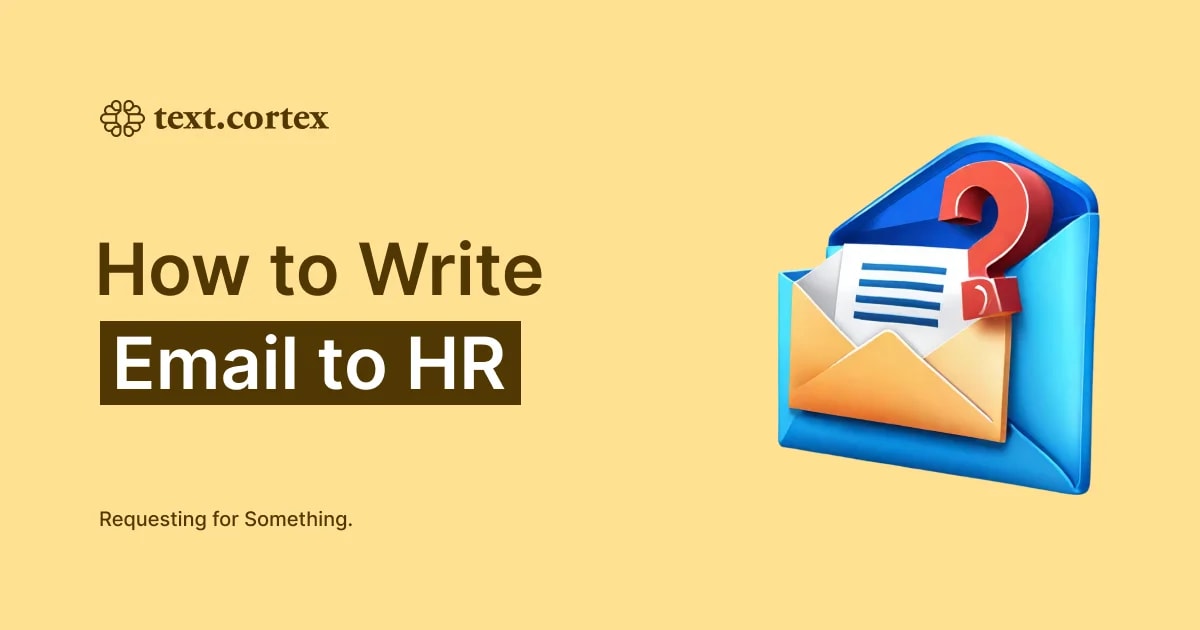
.png)
